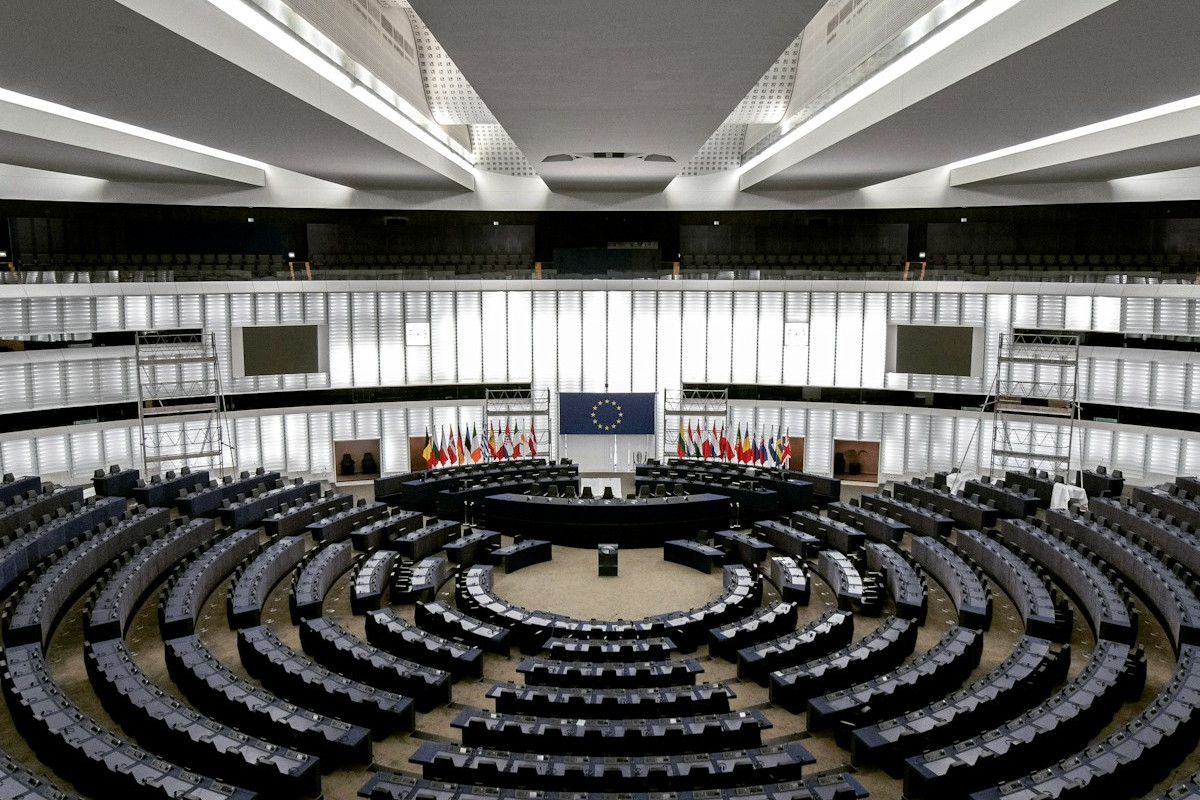The EU Migration Pact: a dangerous regime of migrant surveillance
Topic
Country/Region
10 April 2024
The #ProtectNotSurveil coalition, of which Statewatch is a member, has issued a statement condemning "the criminalisation and digital surveillance of migrants" that will be ushered in by the new Pact on Migration and Asylum. The laws that are part of the Pact were given final approval by the European Parliament this afternoon. The statement explains how the new legal framework "will enable and in some cases mandate the deployment of harmful surveillance technologies and practices against migrants," whilst laying the foundations for the expanded use of invasive technologies in the future.
Support our work: become a Friend of Statewatch from as little as £1/€1 per month.

Image: Michael Dziedzic, Unsplash
The EU Migration Pact: a dangerous regime of migrant surveillance
On 10 April 2024, the European Parliament adopted the New Pact on Migration and Asylum, a package of reforms expanding the criminalisation and digital surveillance of migrants.
Despite civil society organisations’ repeated warnings, the Pact “will normalise the arbitrary use of immigration detention, including for children and families, increase racial profiling, use ‘crisis’ procedures to enable pushbacks, and return individuals to so called ‘safe third countries’ where they are at risk of violence, torture, and arbitrary imprisonment”.
The New Pact on Migration and Asylum ushers in a deadly new era of digital surveillance, expanding the digital infrastructure for an EU border regime based on the criminalisation and punishment of migrants and racialised people.
This statement outlines how the Migration Pact framework will enable and in some cases mandate the deployment of harmful surveillance technologies and practices against migrants. We also highlight some grey zones where the Pact leaves open the possibility for further harmful developments involving intrusive and violent surveillance and data processing practices in the future.
Migration Pact enables the digital surveillance of migrants
As more intrusive technology will be deployed at borders and in detention centres, people’s personal data will be collected in bulk and exchanged between police forces across the EU, and biometric identification systems will be used to track people’s movements and increase policing of undocumented migrants. The New Pact on Migration will mandate a whole range of technological systems to identify, filter, track, assess and control people entering or already in Europe.
These systems will reinforce an already cruel status quo. European policymakers have opted for years to treat the movement of people into Europe mainly as a security issue. The result is very limited safe and regular pathways to come to Europe, the widespread criminalisation of many who make the journey, and systematic exploitation and discrimination against those already living here. Investing in technology to serve this already harmful system will mainly benefit the tech and security firms who reap the financial rewards of this agenda - while pushing people into more dangerous routes and giving more licence for racial profiling at our borders and in our communities.
Here are the main ways the Migration Pact creates a dangerous system of migrant surveillance:
- Migrants as suspects: A vast regime of digital monitoring
The Migration Pact expands a wide system of data collection and automatic exchange, leading to a regime of mass surveillance of migrants. The changes in the Eurodac Regulation will mandate the systematic collection of migrants’ biometric data (now also including facial images), which will be retained in massive databases up to 10 years, exchanged at every step of the migration process and made accessible to police forces across the European Union for tracking and identity checks purposes. The minimum age for data collection was lowered from fourteen to six, with the possibility to use coercion should ‘child friendly’ methods fail.
Further, newly created screening procedures and border procedures (Screening Regulation) will mandate various security checks and assessments of all people entering Europe irregularly, including to seek asylum, with a potential for automated and AI-based decision making. These procedures will require the personal and biometric data of every person who enters the EU to be cross-checked against multiple national and European policing and immigration databases, as well as systems operated by Europol and Interpol, increasing the possibility of transnational repression of human rights defenders. People identified as posing a “risk to national security or public order” will be pushed into accelerated border procedures with fewer safeguards for the processing of the asylum application (Asylum Procedures Regulation and Return Border Procedure Regulation). Not only are concepts of national security and public order dangerously vague and undefined terms leaving wide discretion for Member States, they also pave the way for potentially discriminatory practices in screening procedures, using nationality as a proxy for race and ethnicity in these assessments. Further, even families with children and unaccompanied children could be held in border procedures, with a high risk of being de facto detained.
In the context of asylum procedures, the Pact will enable intrusive technological practices in various stages of asylum processing. The Asylum Procedures Regulation provides for increased searches of personal items, paving the way for invasive practices like the extraction of mobile phone data, which involves seizing and mining personal electronic devices (such as phone or laptop) to extract data that may be used to find evidence to assess the truthfulness of their claims (for instance, in an asylum proceeding) or check their identity, age or country of origin. Such invasive practices have been successfully challenged in Germany and in the UK but continue to be used in several European countries. Moreover, the Asylum Procedures Regulation also allows for the use of remote interviews and videoconferencing for people in detention and during the appeal procedure. This not only raises privacy and data protection concerns, it heightens the isolation of people who are already in a vulnerable situation and risks negatively affecting the quality and the fairness of the procedures.
- Technological management of prison facilities for migrants
The newly introduced screening and border procedures will lead to more people, including children and families, being held in prison-like detention facilities modelled on the “Closed Controlled Access Centres” already operating in Greece. These centres are characterised by motion-sensors, cameras and fingerprint-access, modelling a system of digital management of immigration facilities that relies on high-tech surveillance to monitor and control people. Under the Pact, a minimum of 30,000 people are expected to be in “border procedures” at any one time, likely involving detention or restrictions on movement. Far from treating detention as a “last resort”, chillingly, the Pact foresees the expansion of detention across Europe.
- Tech-enabled racial profiling at the EU’s internal borders
Alongside the Migration Pact are other legislative changes to EU migration policy. The Schengen Borders Code Reform, set to be adopted on 24 April 2024, will generalise police checks for the purpose of immigration enforcement, facilitating the practice of racial profiling within EU territory.
This new law encourages the increased use of surveillance and monitoring technologies at both internal and external borders. Technologies such as drones, motion sensors, thermal imaging cameras, and others are used for the identification of people crossing borders prior to arrival and have been shown to facilitate pushbacks.
Opening the door to future expansion of the border surveillance complex
The Migration Pact sits upon existing frameworks governing the use of digital surveillance in migration. The EU Artificial Intelligence Act introduces a lenient framework for the use of AI by law enforcement, migration control and national security agencies, provides loopholes and even encourages the use of dangerous surveillance systems on the most marginalised in society.
In this framework, combined with the Migration Pact and new existing developments in surveillance technology, we can expect:
- Automated profiling and risk assessments for security and vulnerability checks in order to allegedly facilitate decisions related to asylum procedures, security assessments, detention, and deportation of migrants. The Pact alludes to numerous instances in which AI-based decision making may be used, such as during the screening procedure to assess if someone represents a “national security risk” or a threat to the “public security”, or to assess the level of vulnerability of an asylum applicant. Not only may this lead to numerous violations of data protection obligations and infringements of privacy, but by nature violate the right to non-discrimination in the insofar as they codify assumptions about the link between personal data and characteristics with particular risks. The introduction of automated assessment in asylum procedures will mean fewer protections and safeguards, and further divergence from a principle of case-by-case, individualised and needs- based assessments in the access to international protection.
- The use of forecasting tools that build on biassed statistical data collected on irregular entries and asylum applications to attempt to predict large-scale movements of people, and that can be used to inform actions on the ground to deter or interdict those movements. A similar tool has been tested in the Horizon 2020 project ITFlows.
- Lie-detectors that claim to tell if someone is being truthful by analysing facial movements, which are dangerous and unreliable enough to be banned under the EU’s AI Act – except in the border and policing contexts.
- Dialect recognition systems and other intrusive technologies used in the context of asylum or visa applications, to assess the veracity of applicants’ claims. This technology, in addition to reinforcing a generalised framework of suspicion towards people seeking asylum, is based on unscientific and often biassed, discriminatory assumptions that inform real-world decisions that have a huge and detrimental impact on people’s lives.
- Border surveillance technologies such as remote biometric identification in border areas, drones and thermal cameras to prevent border crossings into and within the European Union. While some surveillance technologies are already in use, a wide range of systems are heavily tested in EU-funded projects like FOLDOUT Solution, ROBORDER, BorderUAS, Nestor. Their use at internal borders is encouraged by the Schengen Borders Code.
What’s next?
In its final version, the Pact represents the further embedding of surveillance technologies in the EU, and beyond, as an increasingly key part of its arsenal to sustain Fortress Europe. It therefore represents a further erosion of fundamental rights, and the normalisation of digital surveillance at, and within, borders, justified by an approach to migration policy based on repression rather than rights.
As the #ProtectNotSurveil coalition, we will continue to challenge the use of digital technologies at different levels of EU policies and practice and advocate for the ability of people to move and to seek safety and opportunity without risking harm, surveillance or discrimination. The coalition will release a more detailed analysis of the digital impacts of the Migration Pact in due course.
To learn more about the coalition’s work or join our efforts to challenge digital policing in migration, get in touch: info [at] protectnotsurveil.eu
The #ProtectNotSurveil coalition
Access Now, Equinox Initiative for Racial Justice, European Digital Rights (EDRi), Platform for International Cooperation on Undocumented Migrants (PICUM), Refugee Law Lab, AlgorithmWatch, Amnesty International, Border Violence Monitoring Network (BVMN), EuroMed Rights, European Center for Not-for-Profit Law (ECNL), European Network Against Racism (ENAR), Homo Digitalis, Privacy International, Statewatch, Dr Derya Ozkul, Dr. Jan Tobias Muehlberg, and Dr Niovi Vavoula
Our work is only possible with your support.
Become a Friend of Statewatch from as little as £1/€1 per month.
Spotted an error? If you've spotted a problem with this page, just click once to let us know.

